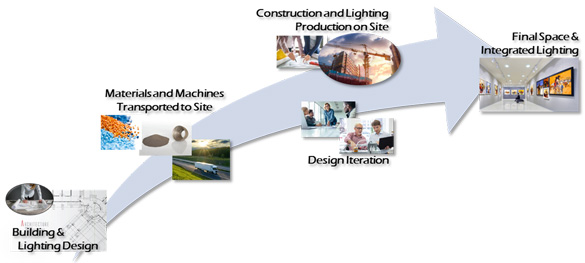The Lighting Research Center (LRC) of Rensselaer Polytechnic Institute, New York, has formed a consortium to explore the potential of 3D printing for solid-state lighting, building, and construction industries. Established with the help of venture capital and private equity company CARBON Group Global, the 3D Printing for Lighting Discovery Consortium features the participation of a number of key 3D printing stakeholders. Following the group’s first meeting in February this year, it is now planning to develop a roadmap that will help integrate additive manufacturing within its areas of interest.
Nadarajah Narendran, LRC Director of Research and consortium lead, states, “We are thrilled to host such a pioneering effort with industry leaders who have a shared vision of adopting 3D printing in the lighting and construction industries.”
Hugo da Silva, VP of Additive Manufacturing at LRC partner DSM, adds, “We are excited that the lighting industry is taking a proactive approach to integrate 3D printing into their operations.”
“I am extremely optimistic about the possibilities enabled by 3D printing, specifically for the various stakeholders in the lighting value chain.”
An evolution in lighting design
While 3D printing for building and construction has become a rather popular sector in recent years, lighting has remained a relatively niche area of application. On a desktop level 3D printed lithopanes have of course been around for years, but in a commercial, or more sustainable end-use setting, lighting is typically reserved to a few, artful one-offs.
In 2018, Philadelphia-based design studio and 3D printer developer Budmen Industries held the All of the Lights installation of 100 3D printed lampshades. Prior to that the industry saw Thyra Hilden and Pio Diaz’s Forms in Nature illusion shade. Most recently, MIT Self-Assembly Lab’s Rapid Liquid Printing technique has been used in some unusual lighting projects, including a display for Design Miami and a recent exhibition at Patrick Parrish Gallery, New York.

Digging deeper into the inner workings of solid state lighting in particular, i.e. LEDs and OLEDs, the 3D Printing for Lighting Discovery Consortium is seeking to make more than just a stylistic display.
“The potential benefits of 3D printing include the ability for manufacturers to create custom products that are uniquely designed for spaces to be illuminated,” states the LRC. “With 3D printing, the manufacture of individual lighting components, such as heat sinks, electrical traces, and optics, could be customized, enabling the design of parts that cannot be manufactured today by traditional methods, improving both aesthetics and functionality.”
The LRC also envisions the potential of on-site, on demand production for such products, “benefitting the user/customer, the manufacturer, and the local construction industry.”
Stratasys, Ultimaker and Desktop Metal join the conversation
The most recent meeting for the 3D Printing for Lighting Discovery Consortium featured the participation of 15 different specialists, from additive manufacturing, lighting and power sectors. In addition to DSM, participants from the 3D printing industry included Desktop Metal, Henkel, HP, Ultimaker and Stratasys. In lighting, power and electronics, participants included Acuity Brands Lighting, Current by GE, Eaton Corp., Finelite, Focal Point, Hubbell Lighting, Lumileds, and Tempo Lighting. In this meeting, participants shared ideas and insight into the current possibilities with 3D printing, focusing on how best to assimilate the technology for the mutual benefit of everyone involved.
One of the takeaways was that research is still needed to advance 3D printed lighting and components beyond the prototype stage. Much of the LRC’s research so far has been in the form of initial investigations into the technology’s potential, including thermal characterization which will be a key developmental challenge for the project.
The 3D Printing for Lighting Discovery Consortium’s next meeting is scheduled for April 2019.

To stay up to date with all the latest 3D printing applications news subscribe to the 3D Printing Industry newsletter, follow us on Twitter, and like us on Facebook.
Search and post on 3D Printing Jobs to find new design opportunities and talent.
Featured image shows the closeup of an LED lightbulb. Photo by Matt Barber/Flickr



